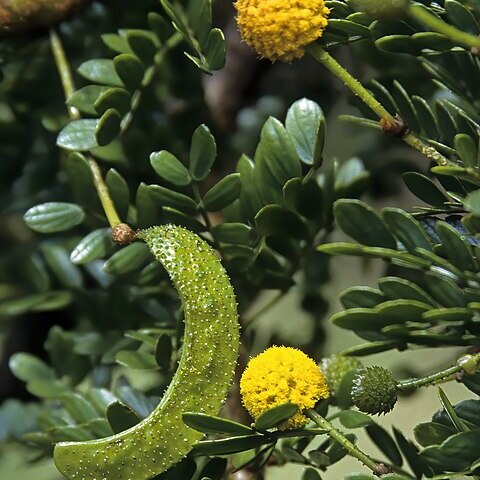Many stemmed shrub with slender ascending branches or sometimes a slender tree, 1-5 m high. Bark dark reddish-brown to purplish-black or black, rough; young branchlets dark reddish-brown to blackish, flaking minutely, with numerous sessile glands, often glutinous, glabrous or subglabrous. Stipules spinescent, in pairs, 0.5-6.5 cm long, straight or slightly reflexed, slender, whitish, tips usually reddish-brown; other prickles absent. Leaves: petiole 0.5-1.8 cm long, adaxial gland often absent, sometimes a rather large sessile gland at or below the junction of the lowest pinna pair; rhachis (0)2.5-4.7(6.8) cm long, glabrous or subglabrous, with a small sessile gland at the junction of the top 1-3 pinnae pairs, smaller scattered sessile glands present and sometimes numerous; pinnae (1)5-10(17) pairs; rhachillae 0.6-3.4 cm long, glabrous or subglabrous, glandular; leaflets (5)8-15 (18) pairs per pinna, 1.5-5 x 0.8-2.2 mm, linear-oblong, margins clearly crenulate-glandular, surface glandular-punctate, glabrous, apex rounded to subacute or shortly spinulose-mucronate. Inflorescences capitate, on axillary peduncles, solitary or fascicled, forming terminal racemes. Flowers bright yellow, sessile; peduncles 1.6-3.4 cm long, glabrous or subglabrous, glandular; involucel at or above the middle of the peduncle. Calyx glabrous or subglabrous, tube 1.2-1.8 mm long, lobes up to 0.5 mm long. Corolla tubular, glabrous, tube 2-2.5 mm long, lobes up to 0.8 mm long, spreading slightly, often reflexed. Stamen-filaments free, up to 4.5 mm long; anthers with a deciduous apical gland. Ovary up to 1.4 mm long, shortly stipitate, glabrous. Pods dark brown to reddish-brown or blackish, 2.8-7.5(10) x 0.5-0.8 cm, slightly to strongly falcate, often curled into an almost complete circle, ± moniliform, irregularly constricted between the seeds, with numerous sessile pustular glands on the surface, glutinous, longitudinally dehiscent, glabrous or subglabrous. Seeds olive-brown, 4.5-6 x 3.5-5 mm, elliptic to subcircular, compressed; areole 2.5-4 x 2.5-3.5 mm.
More
Many-stemmed shrub or tree, up to 5 m high. Leaflets glandular-punctate with conspicous glands on lower surface and on margins, margins appearing crenulate-glandular. Pods slightly to strongly falcate or curled into an almost complete circle, glandular, viscid. Flowers yellow.


